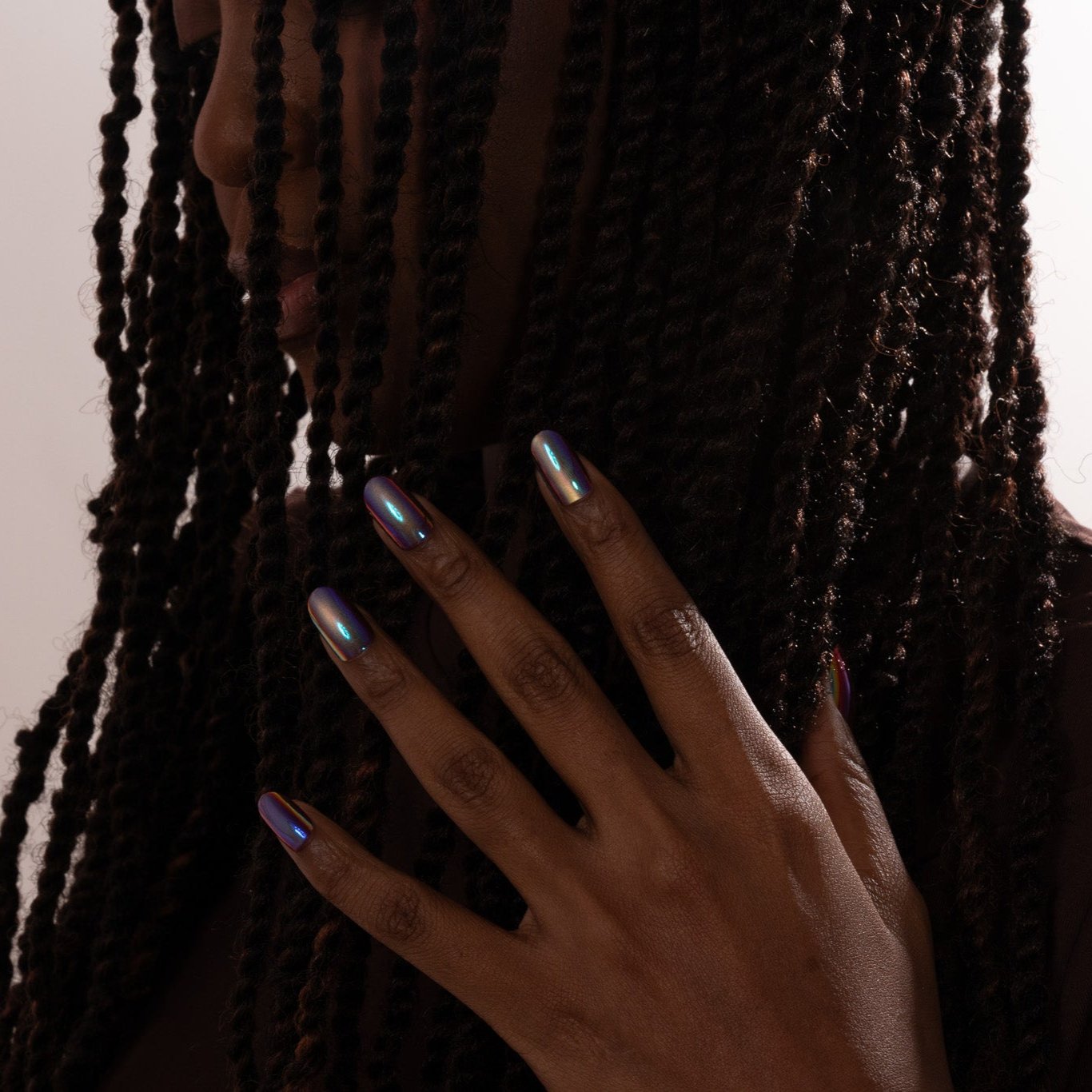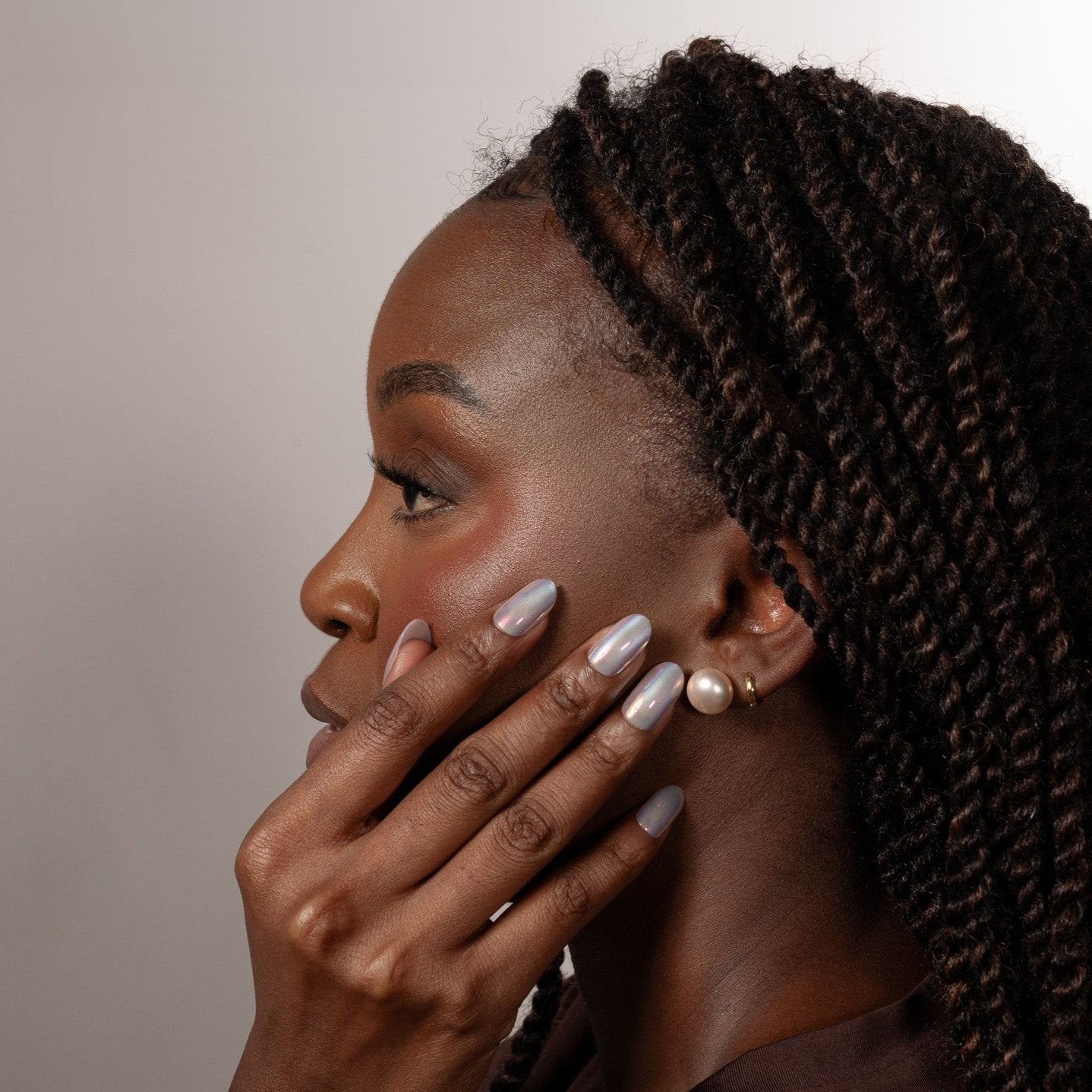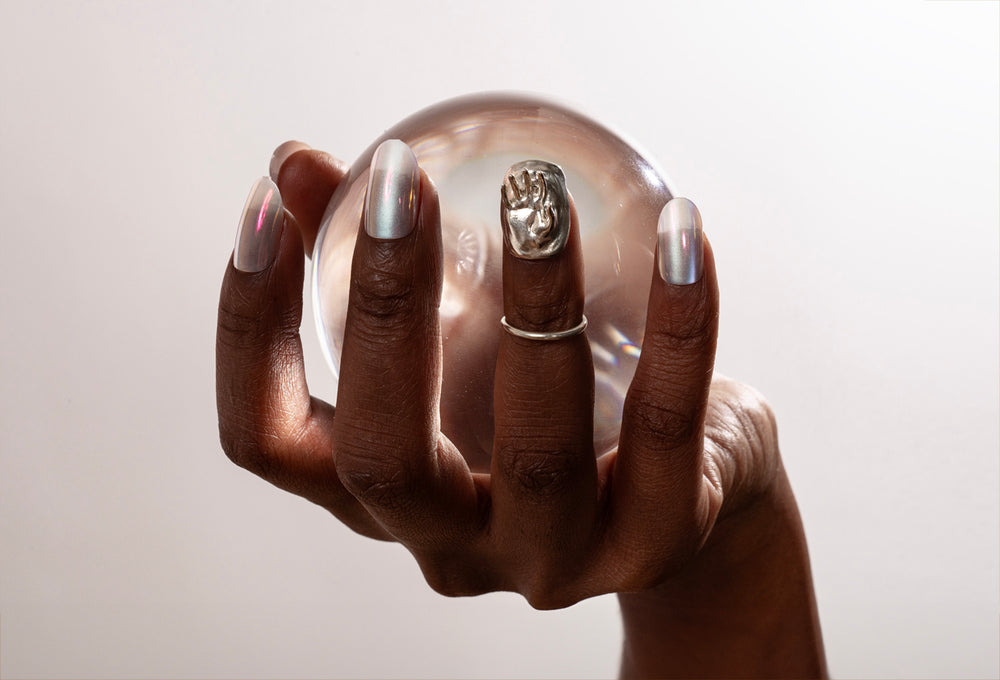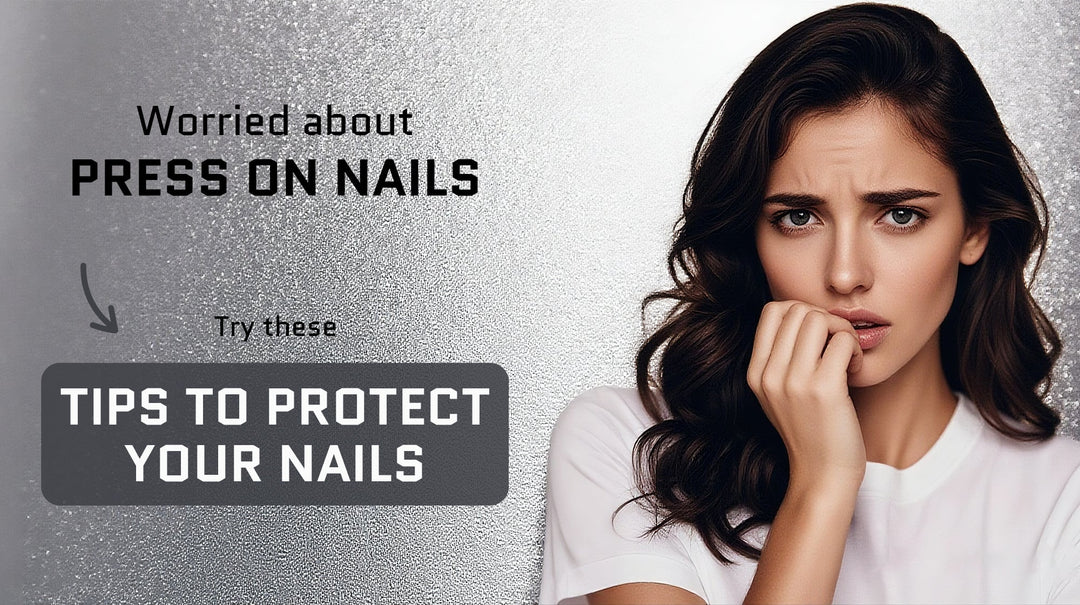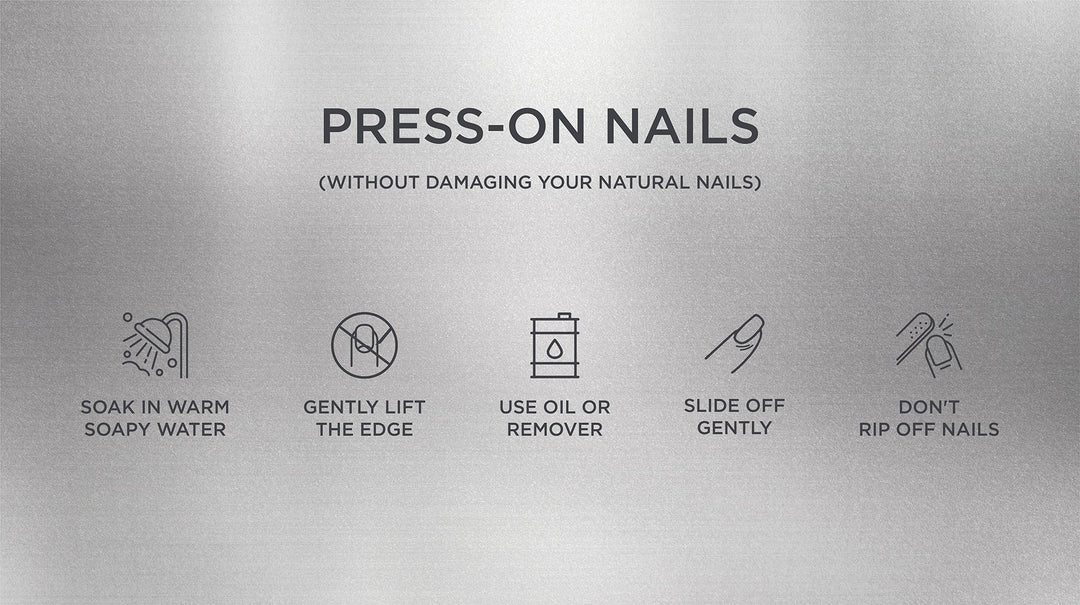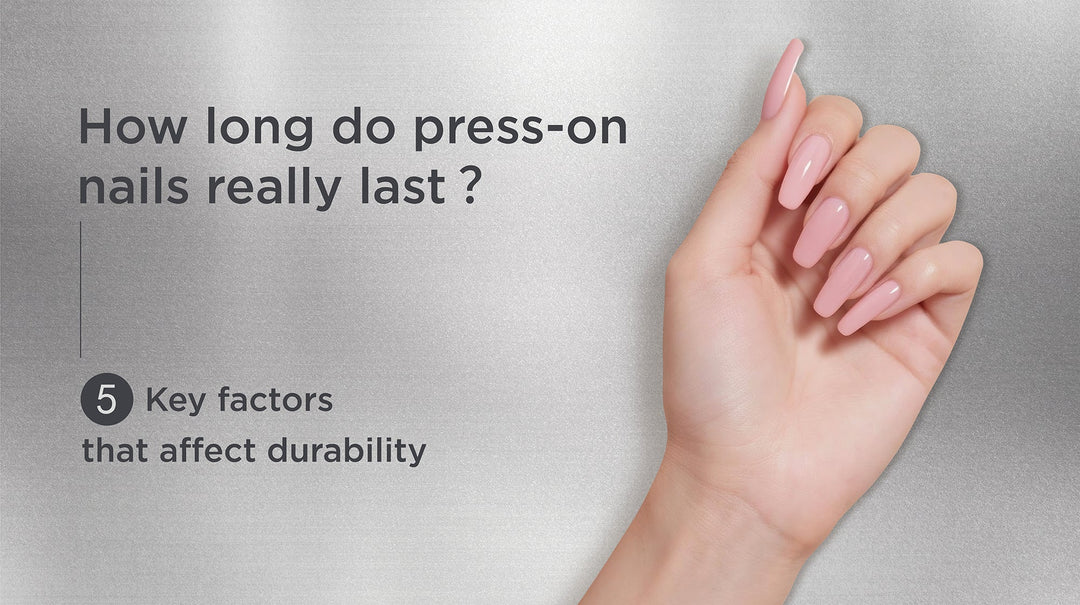Are Press-On Nails Safe? 7 Things You Need to Know, According to Nail Experts
A hand with press-on nails that look like they came from a salon. You can get a perfect manicure at home with press-on nails — but are they safe for your natural nails?
Press-on nails are back in style, and they are a quick and cheap way to get a salon-quality manicure at home. But if you know a lot about beauty, you might be wondering if press-on nails are safe for your natural nails. This complete guide will teach you seven important things about the safety of press-on nails, with advice from dermatologists and nail technicians. We'll talk about everything from the risks of infection and the ingredients in the glue to the differences between press-ons and acrylics and gels. You can safely have beautiful nails if you have the right information and take care of them. Let's get started!
1. Do press-on nails hurt natural nails?
The good news is that when used correctly, press-on nails won't hurt your natural nails. Dr. Omer Ibrahim, a board-certified dermatologist, says, "There's nothing wrong with press-on nails, and you don't have to give them up." The problems come from putting them on or taking them off the wrong way self.com). To put it another way, the problem isn't the press-ons themselves; it's how you use them.
That being said, press-on nails can cause some temporary problems with your nails if you don't put them on or take them off correctly. Some common mistakes are putting too much glue on the fake nails or pulling them off without the right tools:
- Too much pressure or a tight fit: Putting too much pressure on your natural nail by pressing a press-on nail too hard can hurt the nail plate and matrix (the area where the nail grows). This could cause your nails to have bumps or indentations on the surface. Those dents usually go away on their own in a few months( self.com), but if you hurt the nail matrix, it could make your nails grow thinner or slower( self.com ). The key is to apply with a light touch; don't push down too hard. Let the glue do the work
- Taking them off the wrong way (ripping them off): This is the thing that causes the most damage. If you pull off press-on nails too hard, you can also pull off the top layers of your natural nails( self.com). Until those layers grow out, this can make your nails feel thin, bumpy, or peeling. There may even be white spots on the nail due to keratin damage, but these usually go away on their own after a few months( self.com).
In very rare cases, very rough removal could cause onycholysis, which is when the nail plate separates from the nail bed. This is painful and can lead to infection(self.com). But if you take off press-ons carefully and correctly, they probably won't hurt you too much. Braelinn Frank, a nail artist, agrees that press-ons are "one of the safest options for extensions in the book — if you remove them properly"(byrdie.com). We'll talk about safe ways to take things away in a minute.
Bottom line: Press-on nails won't hurt your natural nails. It's all about how you do it. You can use press-ons without hurting your own nails if you put them on and take them off correctly (more on that below)(self.com).A lot of people use press-ons to give their natural nails a break from the harsh treatments at the salon.
2. Ingredients that are safe vs. harmful: What are the nails and glue made of?
When thinking about how safe press-on nails are, you should look at the nails and adhesives' ingredients. Not all fake nails and glue are the same. Here is what nail professionals say about what is safe and what could be dangerous:
- Press-On Nails That Are Not Toxic: Most good press-on nails today are made of gel resin or ABS plastic that is safe for people. They don't usually have harmful chemicals like formaldehyde, toluene, and DBP that are in some nail polishes or acrylic monomers( lemon8-app.com). You can choose "non-toxic press-on nails" if you want nails and glue that don't contain these harsh chemicals. This is better for your nails and your health in general( lemon8-app.com). A lot of newer brands focus on being "5-free" or "10-free," which means they don't have any common toxic ingredients.
- What is in nail glue? Most press-on nail glues are made with cyanoacrylate, which is basically a "super glue" for cosmetics. They stick together well, but they may have methacrylates in them, which are known to cause allergic reactions in some people( self.com). A lot of nail glues and acrylics use methacrylates, but they are also one of the main causes of allergic contact dermatitis (more on allergies in section 3). Some press-on kits come with sticky adhesive tabs instead of liquid glue. These tabs don't have methacrylates in them and are usually thought to be gentler and less likely to cause allergies( self.com). If you have sensitive skin or have had allergic reactions to nail products in the past, you might want to choose press-ons with adhesive tabs or "non-methacrylate" glues.
- "Soft" or "Not Damaging" Some press-on nail glues are sold as "gentle formula" or "dermatologist tested." Dermatologists say that you can't really make nail glue less harsh, but these products might leave out some of the most common allergens( self.com). They are a good place to start for people with sensitive skin, but they don't guarantee that you won't have a reaction. Dr. Ibrahim, a nail expert, says that these glues have fewer triggers that happen often. If you have sensitive skin, it's best to choose those and still be careful( self.com).
- Materials for Press-On Nails: Most press-on nails are made of acrylic resin or ABS plastic, both of which are safe for use on the skin. Gel polish cured onto an ABS base might be used to make higher-end press-ons. Make sure that the press-ons you buy are from well-known brands that use high-quality materials. Cheap, low-quality fake nails might use plastics or coatings that are not as good as they could be or that have chemicals that make you feel bad. If you're worried, look for brands that stress using "high-quality" or "medical-grade" materials. Some press-on sets, for instance, say they use "odorless, non-toxic, safe" ABS plastic that is safe for skin(Naileph.com).
If you're really picky about what's in your nails, look for press-on nail brands that say they are "non-toxic." Also, read the descriptions of the products. Many will say they don't contain formaldehyde, toluene, or other harmful chemicals. For example, brands like Olive and June or Static Nails focus on clean ingredients and even sell glue removers that don't smell or hurt you(self.com). You won't be exposing your nails or skin to bad chemicals if you buy good press-ons.
3. Be aware of the risks: infections, fungal problems, and allergic reactions
Even though press-on nails don't use the harsh chemicals that salon acrylics do, there are still some risks to know about. Nail professionals say that infections, fungus, and allergies are the three biggest problems. Here's what you need to know and how to stay away from these issues:
Press-On Nail Infections: Dermatologists say that fake nails can hold in moisture and make a damp place where germs can grow(wndu.com).Water can get under a press-on if it starts to lift or isn't sealed well at the edges. This can cause bacterial infections or even a yeast or fungal infection in the nail. Signs of an infection are redness, swelling, tenderness around the nail, green or yellow discoloration, or pus(wndu.com)(self.com). Paronychia is a common infection that happens when bacteria get into the skin around the nail. It makes the skin red, swollen, and painful(self.com).Make sure your press-ons fit well (no gaps) and don't wear them for longer than recommended (more on that in section 7). This will help you avoid infections. Also, never reglue a lifted press-on without cleaning it first. If a nail has popped up, clean the natural nail and the press-on with disinfectant before putting them back together to avoid trapping bacteria(columbiadoctors.org)(columbiadoctors.org)
Problems with Fungi: Fungi thrive in warm, damp, and dark environments, such as beneath a loosened artificial nail. Putting on press-ons for too long or putting on a nail that has come off can make nail fungus (onychomycosis) (columbiadoctors.org)worse. Nails that are yellow, thickened, or crumbly are common signs of a fungal nail infection. Dermatologists say that keeping press-ons on for more than two weeks raises the risk of fungal infections because the glue will start to break down and make small holes where moisture can get in. People who wore acrylics for months were more likely to get fungus, but press-ons make it easy to avoid that. The answer? Don't wear them for more than the recommended time (usually 1–2 weeks), and give your nails a break between sets. If you see any changes in the color or shape of your nails, take off the press-ons and let your nails rest to make sure it's not fungus starting.
Allergic Reactions: Allergies are another thing to worry about. Some people may get allergic contact dermatitis from the glue and the press-on nail material. If you are allergic to nail products, you might notice redness, itching, or a rash around your nails. Dermatologists say that it often shows up on the eyelids or face first. This is because you might touch your eyes with small amounts of allergen on your fingers(self.com). The methacrylates in nail glues and gel resins are the main things that cause allergies. If these chemicals touch your skin, like glue getting on your cuticles, they can cause your immune system to react. Dr. Hadley King says that it's very possible to be allergic to nail glue and get red, swollen, or flaky skin from it(self.com). There are two types of reactions: an immediate irritant reaction (burning, pain, or blistering right after applying; in this case, remove the nails right away) and delayed allergic reactions that happen over time with repeated exposure(drdananails.com)(drdananails.com).People with eczema or sensitive skin are more likely to get the latter(drdananails.com). To lower the chance of getting an allergy, try not to let nail glue touch your skin or cuticles while you put it on. Using sticky adhesive tabs or putting a clear protective base coat on your nail first (as a barrier) can also help. Stop using that product right away if you ever feel a strong burning sensation or see a rash forming. If you're not sure, do a patch test: put on one press-on nail and wait a few days to see if you have a reaction before doing the whole manicure(columbiadoctors.org).
How to Keep Yourself Safe: The main idea behind avoiding infections, fungus, and allergies is to use things correctly and keep things clean.
Here are some quick tips to help you stay safe:
- Make sure your press-on nails are clean and dry. Don't put your hands in water for a long time (wear gloves when you do chores) and dry under your nails after washing your hands.
- Don't forget to lift nails. If an edge starts to lift, don't just glue it back down. Clean it first. Take out the nail, clean the area with rubbing alcohol ( columbiadoctors.org), and then put it back on.
- To keep your nails from trapping moisture for too long and to catch any problems early, give them short breaks between press-on sets.
- If you have sensitive skin or have had allergic reactions to nail products in the past, you might want to only use brands that say their press-ons are hypoallergenic or have been tested by a dermatologist. You can also put nail guards or a coat of clear polish on your natural nail before putting on press-ons. This makes a barrier between the glue and your nail or skin( drdananails.com).
- If you notice any warning signs, like pain, swelling, or discoloration, take off the press-ons right away. If you're not sure, see a dermatologist if you think you have an infection or an allergic reaction that isn't getting better( wndu.com).
Dr. Taryn Murray from Cleveland Clinic says that if you notice changes in your nails or signs of infection, you should see a dermatologist as soon as possible. If something looks or feels wrong, it's always better to be safe and get a professional opinion.
4. Which is safer: press-on nails or acrylics and gels?
How safe are press-on nails compared to acrylic nails or gel manicures done at a salon? Most nail professionals agree that press-ons are better for your nails than regular acrylic extensions. They also avoid some of the risks of gel manicures.
Here's a quick look at the differences between press-ons, acrylics, and gels:
No Drilling or Harsh Chemicals (Press-Ons): When you get acrylic nails at a salon, the technician usually has to file or drill the surface of your natural nails to make them rougher so that the acrylic sticks better. They also use a liquid monomer, which usually has strong chemicals in it, to make the acrylic. You don't need to do any of that with press-on nails. You might buff your nail lightly, but there's no electric drill thinning out your nail plate and no smelly chemicals being put directly on your nail(byrdie.com). According to nail artist Braelinn Frank, press-ons are "pure glamour" for your nails(ubling.us) because there is "no drilling, no harsh chemicals." Acrylics, on the other hand, can make natural nails weaker over time, especially if you use them a lot and have to file and soak them in acetone to get them off(byrdie.com).
Removal is easier and safer: To take off gel or acrylic nails, you usually have to soak them in acetone for 15 minutes or more. This dries out your nails and skin(byrdie.com). To take off acrylic nails, you may also have to drill more holes or pry off the extensions, which can hurt the top layers of the nail. On the other hand, press-on nails can be taken off with just warm soapy water and gentle rocking, or a removal solution(byrdie.com) that doesn't contain acetone. You don't need to be around chemicals for a long time. Frank says that your poor "nail beds are crying" from the acetone soak and heavy buffing needed to get the acrylics off(byrdie.com). When done right, press-ons don't have to go through these painful steps to remove, which means less damage and dryness for your natural nails.
Exposure to UV Light: You need to cure gel nails under a UV or LED lamp. Some people are worried that repeated exposure to UV light, like in nail lamps, could damage your skin or even cause cancer on your hands over time. Researchers are still looking into the risks, but UV exposure is a factor with gels (self.com). You don't need any UV light for press-on nails, so you can skip that step. Press-ons are a safer option for people who are afraid of UV lamps or have skin that is sensitive to light. They still give the look of a gel manicure without the UV step.
Allergies and Sensitivities: Some people are allergic to the resins in gel polish or to acrylic monomers, especially MMA, which is an acrylic ingredient that is banned in many places for safety reasons. If you've had those allergies, press-ons might be a good choice. Experts say that custom press-on nails can be a safe place for people who are allergic to gel or acrylic ingredients(dippycownails.com). If the press-ons are made with high-quality, fully cured gel polish (or just painted plastic), they usually won't cause the same reaction as uncured gel or acrylic chemicals. If you are allergic to gel nails, you might want to try press-ons from a well-known, experienced brand or nail tech who uses hypoallergenic gel polishes(dippycownails.com)(dippycownails.com).
When it comes to nail health, press-on nails are better than acrylics. They are faster, cheaper, and don't need as many invasive methods. Braelinn Frank(byrdie.com), a nail artist, says, "Press-ons are much safer than acrylic extensions." To get acrylics to stick, "technicians have to buff your natural nail until it's paper-thin," she says, which isn't good for your nails.
byrdie.com You don't need to buff press-ons very much, if at all, and you can take them off without soaking them in strong acetone for a long time.
How about gel nails? Dr. King, a dermatologist, says that press-ons and gels can both be good for your nails if you do them right. If you do them wrong, though, they can both hurt your nails(self.com). Gels can be removed with acetone and are exposed to UV light, while press-ons can cause allergies or infections if worn for too long. So they all have their good and bad points. Both can be safe if you're careful, but press-ons are better because they don't need to be soaked in chemicals or UV light.
In short, press-ons are usually thought to be a safer and better option for nails than acrylic extensions. They don't make the natural nail as thin or damaged.(byrdie.com) They also get rid of some of the risks of gel manis (no UV, no acetone soak). A lot of people who love beauty use press-ons to give their nails a break from acrylics or gels while still looking great. Press-ons let you have fun with creative nail designs without hurting your natural nails as long as you use them correctly.
5. Correct Application and Removal Are Important (How to Safely Take Off Press-On Nails)
One of the most important things to know about press-on nail safety is that you need to put them on and take them off correctly. Nail professionals say this a lot: if you put on and take off press-ons the right way, they are safe. Here are the best ways to put on and take off press-on nails without hurting yourself:
How to Apply (Do It Right from the Start)
- Get Your Natural Nails Ready: Start with nails that are clean and dry. Take off any old polish or oils by washing your hands with soap and rubbing alcohol on your nails to dry them out(byrdie.com)( byrdie.com).Also, gently push back your cuticles so you don't glue the press-on on top of them. Lightly buff the surface to give the glue something to hold on to, but don't buff too much (a few swipes is enough)( ubling.us). If you prepare the press-ons correctly, they will stick better and last longer. This means you won't be tempted to use too much glue or force.
- Pick the Right Sizes: Choose press-on nail pieces that are as close to the shape of each natural nail as possible. Most kits have different sizes, so make sure to measure them before you start gluing( byrdie.com). You can file the sides of a press-on that is a little too big to get it to fit perfectly( byrdie.com).Using a nail that is too big or overlaps onto your skin can not only make it pop off more easily, but it can also irritate your skin.
- Use glue sparingly, but not too little. Follow the instructions that come with your kit. For one nail, a small drop of glue (about the size of a pea or smaller) is usually enough( drdananails.com). Some experts say to put one drop on the real nail and one on the fake nail. Don't use too much glue; it can leak onto your skin (which increases your risk of getting an allergy) and make it harder to get off. On the other hand, not using enough glue can cause air pockets and lifting( byrdie.com). A good rule of thumb is to use a thin, even layer that covers most of the nail or a few small drops that will spread out when you press the nail on. For a strong bond, press the nail down and hold it for 10 to 30 seconds( ubling.us). If any glue leaks out at the edges, wipe it off with a tissue right away so it doesn't dry.
- Stay away from the cuticles: When you put on the press-on nail, make sure it is just above your cuticle line and not touching your skin( byrdie.com). Then push it down. This keeps the glue from getting on the cuticle and also keeps pressure off the nail matrix, which is the area under the cuticle where the nail grows. It's better for your nail and skin to keep a small gap (not very noticeable) between the false nail and cuticle.
- Think about a base that protects: As we said before, putting a layer of clear base coat on your natural nails and letting it dry before putting on press-ons can protect them( drdananails.com). You don't have to do this, but it can help keep the glue from coming into direct contact with your nail surface, which could help protect it and make it easier to remove.
How to Take Off Press-On Nails Safely
To avoid damaging your nails, it's important to remove press-on nails the right way. Don't rip or pry them off quickly; that's when you take off layers of your natural nail (ouch!). Instead, dermatologists and nail experts suggest using one of these safe ways to get rid of them:
- Soak in warm, soapy water: This is the easiest and least harsh way to get rid of it. Put some warm water and soap (or oil) in a bowl and soak your fingertips for 15–20 minutes(self.com)( byrdie.com).This will make the glue less strong. After soaking, try gently wiggling each press-on nail to see if it has come loose. Don't pull on it. After a good soak, the fake nail will often start to lift up on its own at the edges. You can use a wooden cuticle stick to gently push under the edge of the nail and help it along, but stop if you feel resistance. If it still won't budge, soak it for a little longer and be patient( self.com). Soaking in short bursts (10 minutes, wiggle your nails, another 10 minutes) can help. Eventually, you won't have to pull on the press-ons to get them off. Be patient and listen to your favorite show or podcast while you soak.
- Oil Method: You can soak your nails in warm oil (like olive oil) or just put cuticle oil around all of the press-on nails, especially where they are lifting. Oils can get under and help the adhesive dissolve or move. Over time, rubbing a lot of cuticle oil at the base of the press-on will get through the glue and loosen it(self.com)( self.com). If you're not in a hurry, this is a great tip. You can start oiling them the day before you plan to take them off.
- Use a product made just for removing things: Some brands sell nail polish remover solutions that are made to break down their glue. For instance, Glamnetic's press-on nail remover comes with a dropper that you use to put it on the edges of the nail. After a few minutes, the press-on comes off easily( byrdie.com). A manicurist suggested a brand called Static Nails that sells a "100% non-toxic, odorless Pop-Off remover." ( self.com)These items don't have acetone in them and are better for your skin. If you have a press-on set that is really well glued and you need to take them off sooner (for example, if one breaks and you want to take the rest off), a remover solution can help you avoid having to pry them off. Always do what the product says to do.
- Don't pry or yank: No matter how you do it, the most important rule is to not force the nail off. If a press-on is resistant, it means that the glue bond is still strong. If you force it, you will probably lose a layer of your natural nail. Keep soaking or add more remover solution until the nail comes off with just a little pressure.
- After removing the nail, take care of it: After you take off all the press-ons, there may still be some glue on your natural nails. You can gently buff off any leftover residue or use a cotton pad with a little acetone to wipe it away. Then, make sure to wash your hands well to get rid of any glue or remover traces( self.com). Finally, use a moisturizing cuticle oil or hand cream to rehydrate your nails and skin( self.com). Even just water can dry out your nails, so give them some moisture love. A light buff and a coat of clear strengthening polish can smooth out any nails that feel rough.
If you follow these steps, you won't have to worry about the horror stories of peeling off pieces of your nail. Dr. Ibrahim said that the main cause of damage to press-on nails is peeling too much(self.com), so take your time when taking them off. Safe removal keeps your natural nails healthy and intact, so they're ready for your next set of press-ons or just to show off for a while.
6. For Skin That Is Sensitive or Nails That Are Weak: Advice from Experts
You can still enjoy press-on nails if you have sensitive skin, allergies, or weak nails, but you should take a few extra steps. Nail experts and dermatologists say the following for people with specific problems:
- Pick hypoallergenic options: Look for press-on nail kits that say "hypoallergenic," "dermatologist tested," or "sensitive formula." This isn't a 100% guarantee, but it usually means that the brand made their glue without common irritants (like many methacrylates)( self.com). Some "dermatologist-recommended press-on nails," for instance, use medical-grade adhesives that were tested to reduce skin reactions. You could look at the product descriptions or the brand's website to see if they talk about safety testing. If you're not sure, press-ons with adhesive tabs (instead of glue) are safer for people with sensitive skin because the adhesive on the tab usually doesn't ooze onto the skin and doesn't have the harsh chemicals that glue does( self.com).
-
Do a Patch Test First: If you've had bad reactions to nail products in the past, it's a good idea to do a patch test or trial nail. Put one press-on nail on your pinky or another finger and wear it for 24 to 48 hours to see if it bothers you. If everything is fine, go ahead with a full set. This way, if you are allergic, you catch it early with little exposure( columbiadoctors.org).
- Use nail guards or barriers: Before putting on press-ons, think about putting nail guards (also called nail wraps or protective strips) on your nails. These are clear, thin stickers that you put on your natural nail. Then, you glue the press-on on top of the sticker( self.com). The glue goes on the nail guard, and when you take off the press-on, the guard comes off, leaving your nail plate unharmed. This is great for people who have very weak or thin nails and want extra protection. Putting on a base coat of polish can also protect your nails from coming into direct contact with adhesives, as was said before( drdananails.com).
- Keep it Short and Light: Choose shorter press-ons and lighter designs if your nails are weak or thin. The longer or heavier the nail, the more stress it puts on your natural nail. Dermatologists like Dr. Murray recommend keeping press-on nails at a moderate length because longer extensions can more easily( wndu.com) lever and separate the natural nail from the nail bed. Short, well-fitting press-ons will be easier on weak nails and are less likely to get caught on something or hit something.
- Make it stronger from below: If your nails are weak all the time, use a nail strengthener or hardener on them often. Nail strengthener polish can make your nails stronger over time by adding things like nylon, keratin, or calcium. Putting on a coat of strengthener after taking off press-ons and during breaks will help your nails stay strong. Press-ons will work better on healthy nails.
- Limit how long you wear it: If your nails are sensitive or brittle, you might want to wear press-ons for a little less time than the maximum. Instead of two weeks, maybe only wear them for 5 to 7 days and then take them off carefully. This cuts down on the time your nails are under stress or covered, which lowers the risk of moisture issues. Then, for a few days, leave them bare or just put on a strengthening polish to keep them hydrated and let them heal before your next set.
- If you need to, see a dermatologist: If you've had bad reactions in the past, like severe contact dermatitis from acrylics or gels, talk to a dermatologist. They might suggest certain brands or ways to do things. They can do allergy patch testing in some cases to find out which chemical is causing the problem so you can stay away from products that contain it. There are so many press-on options available now that you should be able to find a safe one with some help.
Keep in mind that everyone's nails and skin are different. What works for your friend might not work for you. Even people with sensitive skin or fragile nails can usually enjoy press-on manicures safely if they follow these steps. Finding the right products and routine for you is the key. And don't give up hope. Many people who are allergic to gel or acrylic have found that they can wear press-on nails without any problems by switching to better, custom press-ons that use gentler ingredients(dippycownails.com). It may take some trial and error, but there are definitely safer press-on options for people with sensitive nails.
7. Tips from experts on how to wear safely and reuse
Finally, let's go over some expert advice on how to wear press-on nails safely for a long time, including how to make them last and even how to use your favorite sets again. Press-ons can be a flexible and even eco-friendly choice for your manicure needs if you take care of them. The experts say this:
- Don't Stay Too Long: Most experts agree that you shouldn't wear press-ons for more than 10 to 14 days straight( self.com), even though it may be tempting to do so. Adhesives break down over time, even if they still look good. Dermatologists say that wearing fake nails for more than a couple of weeks can make it easier for moisture to get trapped and cause infections or fungus( self.com). A lot of people think that one week is the best time for safety and nail health. You should definitely take them off after two weeks. Taking breaks from your nails every once in a while (even just a few days) will keep them healthier in the long run( self.com). It's like letting your nails "breathe" and get some moisture.
- Give Your Nails a Break: Dermatologists say that a good rule is to take a week off after each set of press-ons( self.com). For instance, you could wear press-ons for one to two weeks, then go without polish or just clear polish for a week before putting them back on. During this break, you can use cuticle oil to keep your nails moisturized, and it gives any small damage time to grow out or heal. This is a very important tip if you plan to wear press-ons all the time.
- Safely boost your longevity: To keep your press-on manicure looking good for a long time (so you don't want to mess with them), follow these tips that won't hurt your nails:
- Choose shorter styles for better durability. Long, dramatic nails are fun, but shorter press-ons put less stress on the glue bond, so they're less likely to catch and pop off( byrdie.com).
- Don't stay in water for long periods of time. It's best to keep your nails dry for at least an hour or two after putting on the glue so that it sets completely( ubling.us). Put on gloves when you do chores like washing dishes to keep your press-ons safe (water is bad for the glue). Also, don't take really hot baths or spend too much time in the sauna, as these could make them looser.
- Be careful; press-ons aren't tools! Don't use your nails to open cans, scrape off stickers, or do any other heavy work. Treat them like you would gel or acrylic nails.
- You can also put a clear top coat on top of the press-ons after you put them on. This can help seal the edges and make them stronger, which will keep them from chipping and give them a more realistic glossy look( byrdie.com).
- How to Use Press-On Nails Again: Many types of press-ons can be used again, which is great because it saves you money and cuts down on waste. To reuse them, you need to take them off carefully (as mentioned) so they don't break, and then clean off any glue that is still on the back of the press-on. You can often gently file or buff off old glue chunks from the inside of the press-on nail. Braelinn Frank, a nail artist, says that if the press-on nails are strong, you can use them for more than one manicure( byrdie.com). Her advice is to use adhesive tabs or a smaller amount of glue for a shorter wear if you plan to reuse them. This will make them easier to take off and keep the nails intact( byrdie.com). For example, you can wear them for a weekend event and then take them off and put them back on with new glue later. Some brands of press-on nails even sell extra glue or adhesive tabs because they know you'll want to use the set again.
- Storage: After you wear and take off a set that you want to use again, clean them up and put them back in their box or a small container. Make sure they are dry and that there is no acetone or remover residue on them, as this could damage the material. If you paint them with gel polish, keeping them out of the sun and heat will also stop them from warping or fading.
- When to Throw Away: Not every press-on will make it through several rounds. It's probably time to throw away a set of nails if one of them cracks, splits, or the design starts to peel. Also, even cleaned press-ons can have bacteria in tiny scratches over time, so use your best judgment on how many times to reuse them and always clean them (you can wipe them with alcohol) before putting them back on.
- Expert Opinion: Some top-notch press-on brands make their nails so that they can be used again and again. They might tell you how many times you can wear them. For instance, users of one brand said that their press-ons lasted more than two weeks and could be used again, keeping their good looks(lemon8-app.com)( lemon8-app.com) You might have to pay a little more up front for those stronger press-ons, but you'll get a lot of use out of them. Using nails more than once is better for the environment and costs less.
You can safely and regularly enjoy press-on nails by following these tips, which will help you get the most out of each set. Many fans like press-ons because they let them change their style often (fun designs for the weekend, low-key nails for the work week) without the damage or commitment of salon nails. One nail expert said that press-ons let you "change your look faster than you can say 'nail appointment'"!(ubling.us)Just remember to always take care of your natural nails between style changes.
Conclusion: Safe, Stylish Nails—Press-Ons Done Right
Press-on nails are a safe and stylish way to get your nails done instead of going to the salon, as long as you use them correctly. Nail experts have told us that press-ons aren't bad for your nails on their own(self.com); problems only happen if you use them wrong. You can have as many manicures as you want with little risk if you choose high-quality, non-toxic press-ons, put them on and take them off correctly, and take care of your natural nails. A lot of dermatologists and nail techs think that press-ons are better for nails than acrylics because they don't involve heavy drilling or soaking in chemicals.(byrdie.com)(byrdie.com)
To sum up the safety tips:
- Be gentle and clean: Don't trap moisture, look for signs of infection or allergy, and never pull off your nails.
- Give breaks and limit how long you wear it: This stops fungi from growing and keeps your nails strong.(self.com)( self.com)
- Pick the right things: If your skin is sensitive or your nails are weak, use protective barriers, hypoallergenic glues, or sticky tabs to be safe.
Press-on nails are meant to be a fun and easy way to show off your style at the end of the day. When used correctly, they can protect your nails from damage from polish or acrylic while still making you look polished. You can be sure that press-ons "aren't going to take a serious toll on your tips" if you are careful with them, according to a review backed by dermatologists.(self.com)
Lastly, a word about quality: not all press-ons are the same. Use a brand you trust that has high standards for safety and quality. For instance, Naileph's press-on nails are known for their quality because they use high-quality materials (like salon-grade gel polish and strong base tips) and careful manufacturing to make sure that each set looks great and is safe for your natural nails. You can feel good about using Naileph's trendy, reusable press-ons because they are made with non-toxic, cruelty-free ingredients and are carefully made. If you choose a brand that puts quality and safety first, you'll have a great press-on experience every time.
So, are press-on nails safe? Yes, especially if you follow these seven tips from experts. You can confidently embrace this nail trend because you can have beautiful, non-toxic press-on nails that are good for your fingers. You can have all the glam of a manicure without any of the guilt if you take care of it. So go ahead and press on those nails, babe. Your natural nails (and your wallet) will thank you! Have fun trying out your next press-on look while staying safe and looking good. 💅🏼
Sources:
-
Cleveland Clinic – Potential Risks of Using Press-On Nailswndu.comwndu.com
-
SELF Magazine – Are Press-Ons Bad for Your Nails?self.comself.com
-
SELF Magazine – Press-ons vs. Sticky Tabs and Allergiesself.comself.com
-
Byrdie – Press-On Nails 101 (Expert tips on application, removal, and safety)byrdie.combyrdie.com
-
Dr. Dana Stern – How to Protect Your Nails While Wearing Fakes (Nail health insights)drdananails.comdrdananails.com
-
Columbia Doctors – Artificial Nails: Problems and Treatmentcolumbiadoctors.orgcolumbiadoctors.org
-
Lemon8 Beauty – The Rise of Non-Toxic Press-On Nailslemon8-app.comlemon8-app.com
-
Ubling Nail Blog – Press-Ons vs. Acrylics (Nail technician perspective)ubling.usbyrdie.com
